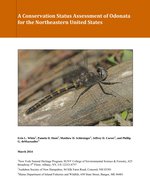Conservation Assessment of Odonata (Dragonflies and Damselflies) in the Northeastern Region
Project Sponsor: Wildlife Management Institute
End Date: March 31, 2014
Summary
This project is the first Region-wide conservation assessment for the order Odonata (dragonflies and damselflies). We are working with partners across the Northeast to compile existing distributional data into a common database, coordinating with the ongoing effort to develop a comprehensive northeastern invertebrate database. These data will be used to assess the regional vulnerability of rare odonates occurring in the northeast and to inform “regional responsibility” for them. It will also prioritize species based on the extent to which regional conservation actions will benefit a species versus actions elsewhere. As a final product we will combine responsibility and vulnerability into a single prioritization matrix and habitat crosswalk and provide a list of high-priority aquatic habitats in the northeast hosting disproportionate numbers of at-risk Odonata.
We conducted a conservation assessment of 227 species of Odonata (dragonflies and damselflies) in the Northeast region of the US in 2012-2014. The study area for this assessment was comprised of states and districts belonging to the Northeastern Association of Fish and Wildlife Agencies (NEAFWA) including CT, DE, DC, MA, ME, MD, NH, NJ, NY, PA, RI, VA, VT, and WV. We received odonate data from 22 project collaborators and compiled these records into a database of over 248,000 records. Please see Table 1. Odonata Data Sources (DOCX, 14.6) for a list of data sources used in our analysis. These records include information on species name, county, state, and country location, year, voucher, and source information.

The project steering committee (Erin White, Jeff Corser, and Matt Schlesinger of NYNHP, Pam Hunt of Audubon Society of NH, and Phillip deMaynadier of ME Dept. of Inland Fisheries and Wildlife) completed a vulnerability and responsibility assessment by the spring of 2014. We worked with Odonata experts and state agency representatives in the region to review our work and provide feedback on our products. We modeled our vulnerability assessment after the approach developed by NatureServe and the network of Natural Heritage programs (Master et al. 2012) for calculating global, national, and subnational (state and province) conservation status ranks. Our regional assessment used three rarity factors (range extent, area of occupancy, and habitat specificity), a threat factor (vulnerability of occupied habitats), and a trend factor (relative change in range) in combination to yield a single regional vulnerability rank (R-rank). NatureServe created distributional range maps for the entire US and Canadian range of all Northeastern Odonata. These maps will be available in the spring of 2014 by species on the NatureServe Explorer website. We calculated regional responsibility as the proportion of the US & Canadian range occurring in the Northeast US. We combined our results of the vulnerability and responsibility analyses into a single prioritization matrix that places species in vulnerability and responsibility categories, and this product is available in our final report (PDF, 1.3 MB) .
Dec. 11, 2020 | Updated Feb. 13, 2021, 8:51 p.m.